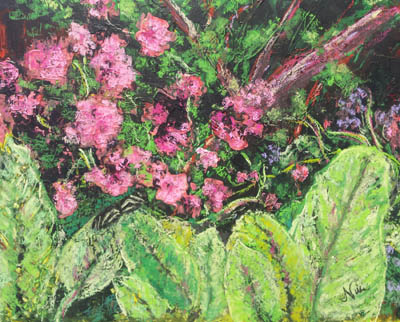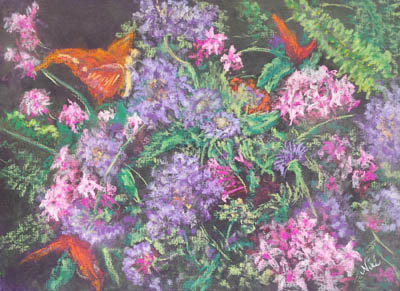The versatility of pastel: creating works with unique textures

“Tropical Night” 17 x 21 Mixed Media on Paper
One of my favorite things about pastel is its versatility. If I feel like following a time-tested, traditional method of using pastel, I can take out some textured paper and create a dry pastel painting. If I feel like experimenting with pastel’s different effects, there are many choices available: using wet pastels, priming a surface with watercolor or acrylic, or using pastel as a finishing layer over an acrylic painting or collage.
In “Tropical Night,” you’ll see that there a variety of textures throughout the piece. I create this effect by using a palette knife to “lay in” a basic painting. After the acrylic has completely dried, I’ll break out the chalk pastels, and scrub them over the different parts of the painting to provide color and texture. It;s always a bit of a surprise to see how the textures come out– I’m not totally in control of the effects as I paint, which is part of the fun! I’ll occasionally layer a little acrylic back over the pastel if needed, which adds to the thick areas of texture throughout the piece.

“Bouquet” 15.5 x 20 Pastel on Acrylic-Toned Paper
Other ways to create interesting texture with pastel include toning paper with different types of paint, or using different surfaces for your paintings. “Bouquet” was painted on acrylic-toned Canson Canva-Paper. The paper has the feel of canvas, giving the pastel strokes a scratchy effect. Toning the paper with dark acrylic gave painting a soft, smudgy feel in some of the areas. I hadn’t used this particular combination before this piece and had to rework it a few times, using water occasionally to blend some of the areas and lift off excess dust that clung to the acrylic.
Experimenting with pastel techniques is always a bit of a gamble, but the surprising effects are often worth the risk. I always feel that each piece has its own creative touch, making each painting a uniquely individual work of art.
1 Comment